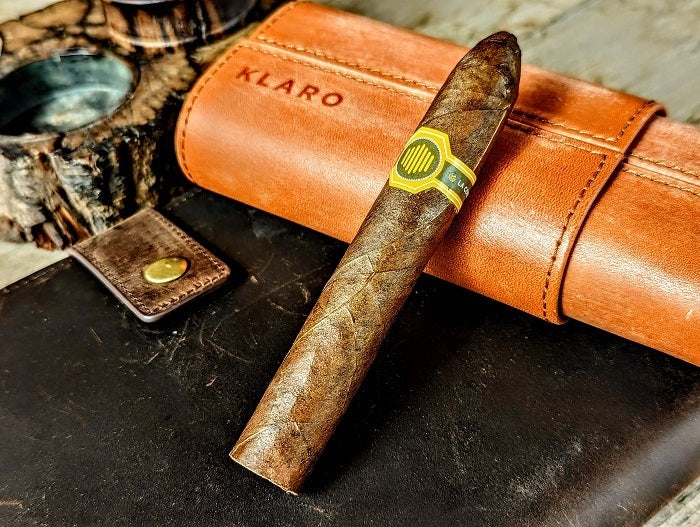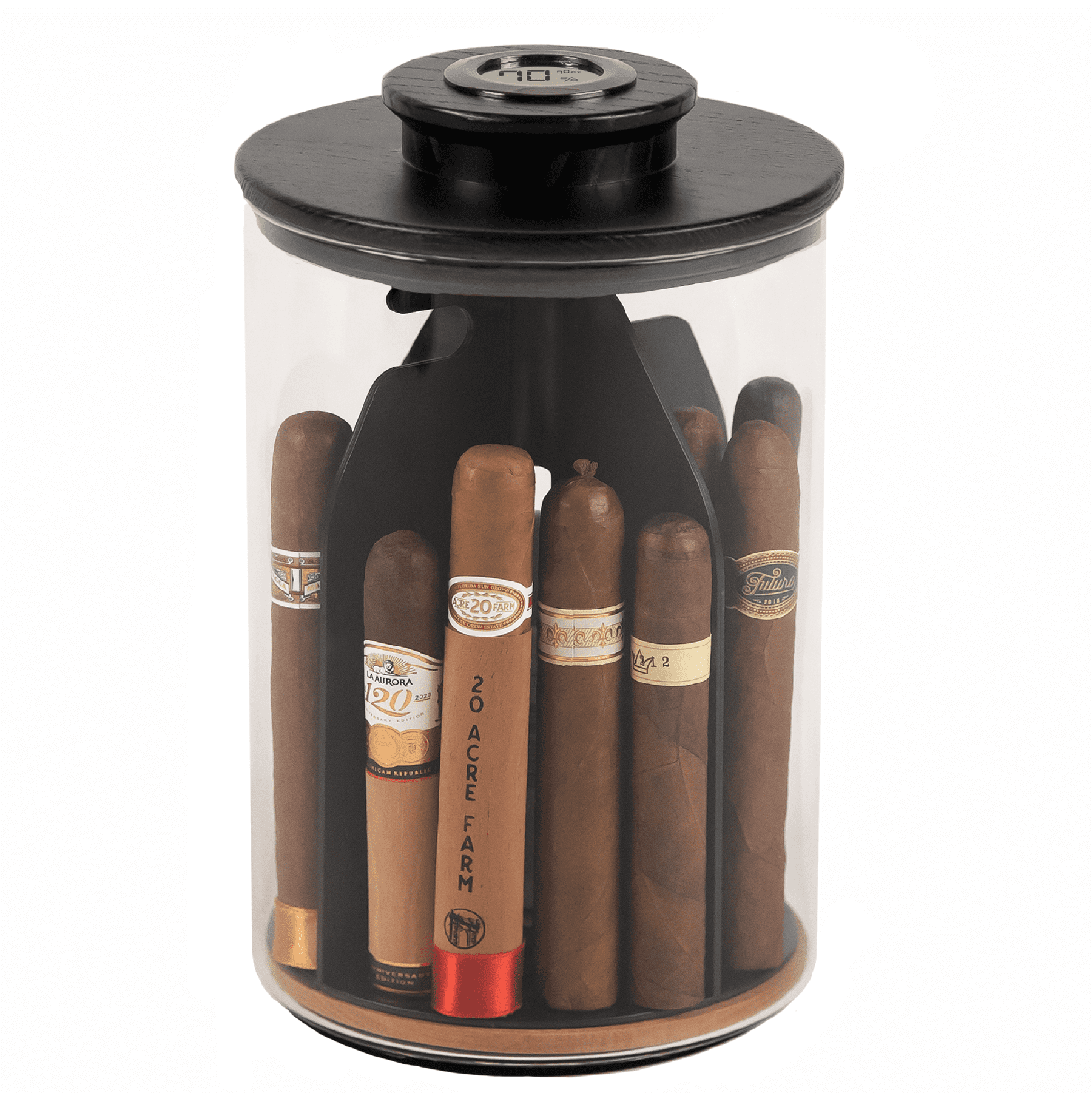Demystifying Cigar Etiquette: To Inhale or Not to Inhale?
The cigar, and tobacco in general, has had significant cultural and geopolitical impact across thousands of years, popularized in medicinal, recreational, ceremonial, and religious uses across several eras and countries.
But it came into American culture’s purview sometime around the Civil War, during the 1860s, when it was quickly popularized not just as a recreational vice but as a status symbol of independence and a more refined alternative to chewing tobacco.
Tobacco and nicotine share an important relationship, and it’s hard to imagine tobacco having as much prominence without the addictive property of nicotine and its effect on those who imbibe. But cigar smoking in the late 19th century was a new take, one that did not put as much importance on the chemical properties of tobacco but on the flavors and nuances of the smoking experience as a whole.
And that sentiment exists today.
A common question (and mistake) among new cigar smokers is whether they should inhale cigar smoke. After all, cigarettes, an arguably more popular version of tobacco today, are inhaled. Why inhale one and not the other? Or are there some cigar smokers who inhale?
Here, we discuss the nuts and bolts of cigar smoking to help you better enjoy the process and experience, and to better and more fully answer the question of whether or not you should inhale.

Understanding Cigar Composition
Let’s start by understanding the basic composition of a cigar. Every cigar is made up of a wrapper, binder, filler, and cap. Look at a cross-section of a cigar, and you should be able to differentiate the wrapper, binder, and filler, as each are made with different types of tobacco leaves.
The wrapper is made from large, mostly seamless tobacco leaves and covers the exterior of the cigar. The binder and filler, as you’d guess, are the internal components, with the binder acting as a holder for the filler tobacco.
Somewhat similar to cigarettes, the inside binder and filler of a cigar is made of shredded tobacco leaves. The binder is often more of a structure component while the filler and wrapper contain the majority of the flavor.
The cigar cap is the closed section of the cigar, where you make a cut. This is formed with small pieces of tobacco. In some cigars, the foot—where you light the cigar—is shaggy or closed. A shaggy foot leaves some of the filler tobacco spilling past the wrapper. A closed-foot closes off the lighting end with the wrapper.
The primary difference between cigars and cigarettes comes down to that wrapper. While cigarettes include cut tobacco as filler, the wrapper is made of thin paper that has little to do with the flavor. Meanwhile, a cigar’s wrapper is an important component not only in holding the tobacco together but also the flavor of the cigar and how evenly it will burn.
The difference in wrapper between a cigar and a cigarette is one of many structural differences—all of which result in two very different smoking experiences.
Cigars are made entirely of tobacco, including the wrapper, binder, and filler leaves, which are carefully selected and blended to create a balanced flavor profile. In contrast, cigarettes contain a blend of processed tobacco leaves mixed with various additives, including preservatives and flavorings. Cigarette tobacco is finely chopped and tightly packed into paper tubes, with filters often added to reduce the inhalation of harmful substances. Cigars contain no filters, and the draw is dictated by how it is rolled, often by hand.

Exploring Inhalation
Inhalation refers to the drawing of smoke into the lungs, which, for cigarettes and cigars, is a delivery method for nicotine. When you smoke a cigar or cigarette, the nicotine is vaporized, which you can then draw into the lungs to be absorbed into the bloodstream. But this process also invites harmful substances into your lungs, such as tar or chemicals.
Cigar smoke is not often inhaled, though there are some who do. If you’ve ever inhaled a cigar—and have also tried a cigarette—you know the smoke produced from a cigar is significantly stronger and harsher. This is a result of a few factors, including the blend of tobacco and the lack of a filter.
Compared to cigarettes, cigars typically contain a higher concentration of natural tobacco leaves compared to cigarettes, which often contain processed tobacco mixed with additives. Cigar tobacco tends to be stronger and more robust in flavor, with more nicotine — which can contribute to a harsher smoking experience, particularly for individuals who are not accustomed to the intensity of cigar tobacco.
But there are a lot of misconceptions when it comes to inhaling cigars, including that inhaling cigars is less harmful than cigarettes, that cigar smoke is more natural so therefore safe, and that cigar smoke does not have any chemicals and is therefore free of health risks. In fact, the lack of a filter allows more harmful smoke should you inhale a cigar.
While it's true that cigars may contain fewer additives, they still produce harmful chemicals when burned, including those associated with the combustion of organic matter. Moreover, the high concentrations of nicotine and other toxins in cigar smoke can pose significant health risks, regardless of their natural origins.

Factors Influencing Inhalation Decision
Still, some cigar smokers choose to inhale when they smoke. And this can be for several reasons.
For starters, cigars range considerably in strength, blend, size, and type. While essentially all cigars will burn longer and slower the cigarettes, shorter and smaller cigars smoke more quickly, which may lead some to experiment with inhaling the smoke. Nicotine is addictive, and inhaling cigar smoke with expose your lungs and bloodstream to higher levels of nicotine, which some prefer.
Some tobacco blends, too, will be less harsh and might appeal to smokers considering inhaling. Lighter wrappers and smoother fillers may lead some cigar smokers to experiment. Depending on their frequency, they may come to enjoy the nicotine and could develop a tolerance.
See, with such a high nicotine content, some novice smokers can feel the negative effects of nicotine even without inhaling. But those who have developed a tolerance to nicotine will be less affected and may even prefer it.

Health Considerations
Some cigar smokers mistakenly believe that inhaling cigar smoke is not quite as harmful as inhaling cigarettes, or that it poses minimal health risks. But you’re still getting a lot of the same harmful substances like tar, carbon monoxide, and carcinogens found in cigarette smoke when you inhale cigar smoke. And this can increase the risk of certain health problems.
While some cigar smokers choose to inhale cigar smoke, this practice can significantly increase the health risks, including an increased risk of developing cancer, heart disease, and respiratory disorders.
But what if I don’t inhale? Yes, puffing cigars without inhaling is generally considered less harmful than inhaling cigar smoke. And that’s for a number of factors, including the lower exposure of those harmful substances we mentioned earlier (tar, carbon monoxide, carcinogens) and lower nicotine exposure, which reduces the effects and the likelihood of forming an addiction to nicotine, which leads to an increased exposure of harmful substance.
And, beyond the health implications, puffing a cigar rather than inhaling it allows you to better experience the flavors and aromas of a cigar — which is why we’re here.
Techniques for Smoking Cigars
Puffing on a cigar without inhaling allows the smoker to focus on appreciating the cigar's flavors, aromas, and textures without the distraction of nicotine's effects on the body. For cigarette smokers, that may sound strange — but the purpose of a cigar is more about the taste and experience than the nicotine.
Watch several cigar reviews, and you’ll see that a stronger, nicotine-heavy smoke isn’t necessarily celebrated. Instead, cigar reviewers will forewarn their viewers if a certain cigar packs a more significant punch, giving them a heads up to temper how quickly they smoke a cigar to avoid the effects of nicotine.
Many cigar enthusiasts prefer puffing as it allows for a more leisurely and enjoyable smoking experience, emphasizing the nuances of the cigar's blend and construction.
And when it comes to puffing versus inhaling, those aren’t the only two options!
Many cigars practice what is called “retrohaling”, which refers to exhaling cigar smoke through the nose instead of solely through the mouth. This exposes the smoke to other areas of your palate and allows you to more fully taste and experience the nuances of the smoke. Though, be forewarned, this can expose you to some of the harsher notes of the cigar.
Instead of exhaling the smoke entirely through the mouth, the smoker allows a portion of the smoke to exit through the nose by exhaling gently. This allows the smoke to pass through the nasal passages and stimulate the olfactory receptors in the nasal cavity.
As the smoke passes through the nasal passages, it comes into contact with the olfactory epithelium, which contains millions of specialized sensory cells responsible for detecting odors. These olfactory receptors send signals to the brain, where they are processed and interpreted as various flavors, aromas, and nuances present in the cigar smoke.
Retrohaling allows cigar smokers to perceive a wider range of flavors and aromas compared to solely tasting the smoke in the mouth.
Retrohaling can enrich the cigar-smoking experience by intensifying the perception of flavors and aromas. It offers cigar enthusiasts a deeper appreciation of the nuances and complexities of different cigar blends, elevating the enjoyment of the smoking ritual.
Cigar Smoking Etiquette
What should you expect when smoking cigars with others, when it comes to inhaling or not? Far and away, most cigar smokers will not inhale their cigars. For many of the reasons listed already, it’s less common to inhale, and some cigar smokers won’t even retrohale because they don’t prefer that experience.
But that’s the main takeaway, here: personal preference matters, and most cigar smokers are respectful of different practices and preferences. And if there’s any etiquette we’d suggest, it’s that — to be respectful of others. That includes cigar smokers and non-cigar smokers.
The Experience of Flavor
Cigars typically offer a wide range of flavor nuances derived from the tobacco blend, aging process, and fermentation. Common cigar flavors include sweet, funky, earthy, woody, spicy, nutty, sweet, and creamy notes, which can vary depending on factors such as the type of tobacco used, the cigar's origin, and its aging period.
Cigars emit complex and aromatic smoke characterized by rich, nuanced scents such as cedar, leather, coffee, cocoa, dried fruit, and floral notes. These aromas are often influenced by the cigar's wrapper leaf, filler blend, and aging conditions.
Inhaling cigar smoke can cause you to miss many of these nuanced flavors and aromas. If you’ve inhaled a cigar before, you know that the shock and action of taking the smoke into your lungs instead of letting it settle on your taste buds changes the experience significantly, and you lose a certain amount of perception.
Professional Opinions
- Insights from Cigar Aficionados
- Expert Recommendations on Inhalation
Common Misconceptions
Let’s cover some common myths about cigar smoking and inhaling.
Myth: Inhaling cigars is for badasses.
Reality: Not so much. You’re welcome to inhale, but doing so more or less takes away from the overall experience of smoking a cigar.
Myth: Only cigarette smokers inhale smoke into their lungs.
Reality: While many cigar smokers choose not to inhale deeply into their lungs, some individuals do inhale cigar smoke to experience the rapid delivery of nicotine. To each their own.
Myth: Inhaling cigar smoke is not harmful.
Reality: Inhaling cigar smoke still exposes the smoker to harmful substances such as tar and carbon monoxide and increases the risk of various health issues.
Myth: Inhaling cigar smoke doesn't cause addiction.
Reality: Nicotine is present in cigar smoke, and inhaling cigar smoke can lead to nicotine addiction, similar to cigarette smoking.
Myth: Inhaling cigar smoke deeply into the lungs enhances the flavor experience.
Reality: Inhaling cigar smoke can overpower or mask subtle flavor nuances, affecting the overall enjoyment and appreciation of the cigar's blend and construction.
Impact on Taste and Aroma
- How Inhaling Affects Flavor Profile
- Balancing Taste with Inhalation
Personal Preferences
So what’s right for you? Even beyond choosing whether to inhale or not, smoking a cigar is a personal experience, and you get to dictate what you prefer — even down to which types of cigars or tobacco blends you are willing to try.
Every smoker is different, and you will like some things that other smokers don’t. Identify what is pleasurable, what smoking techniques allow you to notice nuanced differences when you smoke a cigar, and what impacts the experience negatively. That might even be where you decide to smoke or if you smoke with others!
If you’re still narrowing what you prefer when smoking, check out our tips for beginner cigar smokers below.
Expert Tips for Beginners
Experiment: Take the time to experiment with different smoking techniques, including puffing without inhaling and inhaling cigar smoke into your lungs. Try different cigars with varying strengths, flavors, and sizes to see what suits your palate and smoking style best.
Go Slow! If you're new to cigar smoking, start slow and gradually explore different smoking methods. Begin with smaller cigars or cigarillos and work your way up to larger, full-bodied cigars as you become more comfortable with the smoking process.
Experience the Flavor: Pay attention to the flavors, aromas, and sensations you experience when smoking cigars. Notice how different smoking techniques and cigar sizes affect the overall flavor profile and smoking experience. Focus on savoring the complexities of the cigar's blend and construction, rather than solely on nicotine absorption.
Pay Attention to How You Feel: Be mindful of how your body responds to cigar smoke, especially if you choose to inhale. If you experience discomfort, irritation, or dizziness while inhaling cigar smoke, consider adjusting your smoking technique or opting for puffing without inhaling instead.
So are you supposed to inhale cigars? Simply put, we wouldn’t recommend it. There’s an endless world of flavors and aromas and nuances possible when you smoke cigars. And you don’t need to inhale to experience any of it. In fact, it may be a hindrance rather than a help.
What we do encourage: Experiment with retrohaling, try different cigar types, read cigar reviews, start a cigar journal, spend time thinking about what you like about a certain blend and shop for more like it!














